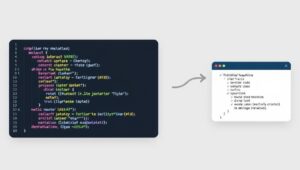Declarative Programming: Defining What, Not How (A 2027 Trend)
In the ever-evolving landscape of software development, certain paradigms rise to prominence, shaping the way we approach problem-solving and code construction. As we look towards 2027, one such trend is the increasing adoption of declarative programming. This article delves into what declarative programming is, how it differs from its imperative counterpart, and why it’s poised to become a significant force in the future of coding.
What is Declarative Programming?
At its core, declarative programming is a paradigm that focuses on what the program should achieve, rather than how it should achieve it. Instead of explicitly specifying the steps the computer needs to take, developers define the desired outcome, and the programming language or environment determines the most efficient way to reach that outcome.
Think of it like ordering food at a restaurant. You tell the waiter what you want (e.g., “I’d like a pizza with pepperoni and mushrooms”), not how the chef should prepare it (e.g., “First, knead the dough, then add tomato sauce…”). The chef, like the programming environment, handles the implementation details.
Declarative vs. Imperative: A Key Distinction
To understand declarative programming better, it’s helpful to contrast it with imperative programming, the more traditional approach.
- Imperative Programming: This paradigm involves explicitly stating the steps the program must take to reach a desired state. It’s like providing a detailed recipe to the computer, outlining each instruction in sequence.
- Declarative Programming: This paradigm focuses on describing the desired outcome without specifying the exact steps. It’s like describing the final dish you want, leaving the specifics of its preparation to the system.
Here’s a table summarizing the key differences:
| Feature | Imperative Programming | Declarative Programming |
|——————|——————————————————–|——————————————————-|
| Focus | How to achieve the result | What result is desired |
| Approach | Step-by-step instructions | Description of the desired outcome |
| Control Flow | Explicitly managed by the programmer | Implicitly managed by the system |
| Examples | C, Java, C++ | SQL, Prolog, Haskell |
Benefits of Declarative Programming
Declarative programming offers several advantages, contributing to its growing popularity:
- Increased Abstraction: By focusing on the what rather than the how, declarative programming raises the level of abstraction, making code easier to read, understand, and maintain. Developers can concentrate on the problem domain rather than getting bogged down in implementation details.
- Improved Code Reusability: Declarative code tends to be more modular and reusable. Since the logic is separated from the implementation, the same declarative statements can be applied in different contexts.
- Enhanced Parallelism: Declarative programs are often easier to parallelize. Because the order of execution is not explicitly defined, the system can automatically distribute tasks across multiple processors, leading to performance gains.
- Simplified Testing: Declarative code is generally easier to test. Since the focus is on the desired outcome, tests can be written to verify that the program produces the correct results, regardless of the implementation details.
Examples of Declarative Programming
Several programming languages and technologies embrace the declarative paradigm:
- SQL (Structured Query Language): Used for managing and querying databases. You specify what data you want to retrieve, and the database system figures out how to get it.
- Haskell: A purely functional programming language that encourages a declarative style. Functions are defined as mathematical expressions, specifying the relationship between inputs and outputs.
- React: A JavaScript library for building user interfaces. You describe what the UI should look like based on the data, and React handles the rendering and updates.
- Prolog: A logic programming language where you define facts and rules, and the system infers conclusions based on those rules.
Why Declarative Programming is a 2027 Trend
Several factors contribute to the rising importance of declarative programming:
- Increasing Complexity of Software Systems: As software systems become more complex, the need for abstraction and maintainability grows. Declarative programming provides a way to manage this complexity by focusing on the essential logic and hiding the implementation details.
- Rise of Functional Programming: Functional programming, which emphasizes immutability and pure functions, aligns well with the declarative paradigm. The growing popularity of functional languages like Haskell and Scala is driving the adoption of declarative techniques.
- Cloud Computing and Parallel Processing: The shift towards cloud computing and parallel processing demands code that can be easily parallelized and distributed. Declarative programming simplifies the development of such applications.
- AI and Machine Learning: Many AI and machine learning frameworks rely on declarative approaches for defining models and training processes. This trend is likely to continue as AI becomes more pervasive.
Challenges and Considerations
While declarative programming offers many advantages, it also presents some challenges:
- Learning Curve: Shifting from an imperative to a declarative mindset can be challenging for developers accustomed to explicit control over execution flow.
- Performance Optimization: In some cases, declarative programs may require careful optimization to achieve desired performance. Understanding how the system implements the declarative statements is crucial.
- Debugging: Debugging declarative code can be more difficult than debugging imperative code, as the execution flow is not always transparent.
Conclusion
Declarative programming represents a significant shift in how we approach software development. By focusing on what the program should achieve rather than how, it offers increased abstraction, improved code reusability, enhanced parallelism, and simplified testing. As we move towards 2027, the adoption of declarative programming is poised to accelerate, driven by the increasing complexity of software systems, the rise of functional programming, and the growing importance of cloud computing and AI. Embracing this paradigm will be essential for developers looking to build robust, scalable, and maintainable applications in the years to come.




